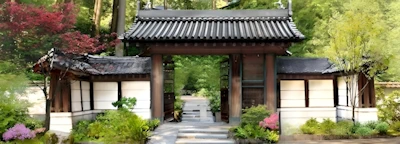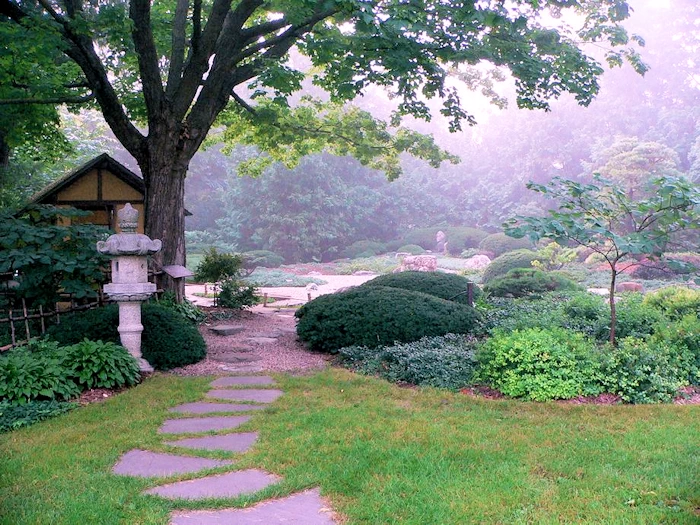Jo Ryo En Japanese Garden (Carleton College)
Event Location
Northfield, MN 55057
Ancient rocks form the basic supporting frame of Carleton College’s compact Japanese garden, nestled behind Watson Hall. One famous contemporary designer of such gardens writes: “Rocks serve as the most important framework in creating a sense of natural landscape. They are just like the bones in a human body; the plant materials being the flesh.” In a Japanese garden the rocks are set so one has the sense they are rooted and anchored in the ground, not sitting on top of it.
The angular, aged specimens in the Carleton garden are varied in size and shape: these lichen-covered rocks were searched for and gathered within a hundred mile radius of Northfield over a period of two summers. They, in combination with a few carefully chosen shrubs and ground cover spread over the gently contoured ‘hill,’ produce a harmony which is further enhanced by the ‘borrowed scenery’ of the long-standing arbor vitae in the background. Lake Superior beach stones become a mountain stream, while the white gravel is transformed into a lake with rock isles and spanned by a gently-bowed wooden bridge (to be enjoyed with one’s eyes, rather than trod upon!). These are the basic elements in the kare-sansui, or dry landscape garden.
A five-and-one-half-foot chiseled salt and pepper granite stone lantern, known as “Kasuga” for the shrine in Nara where its style originated, stands at the entrance to the garden. It contains a place for a candle traditionally used to light the way to a shrine or temple. This Japanese lantern, and a second one called a yukimi, or snow-viewing lantern, were obtained from a retired Minneapolis executive who returned with them after World War II. On the right as one enters the garden is a water basin (chozubachi) with its bamboo pipe dripping water where, by custom, a visitor will pause to wash hands in a symbolic gesture of cleansing.
The nobedan, or stone-paved walk, invites one in measured steps along the sunken granite slabs to leave the work-a-day world behind and gaze upon the garden much as one would view a work of art. This semi-formal walk serves a dual role: its straight line frames the garden scene from below, and it divides that scene (not to be physically entered) from the viewing area which includes a tea-house style pavilion and curved redwood benches.
The design of the garden, as well as its construction, was accomplished by David Slawson between 1974 and 1976 with the assistance of Peter Smith and Marshall Gittler ’76. Dr. Slawson, who received his doctorate in Japanese literature and aesthetics from Indiana University, studied for two years in Kyoto with Kinsaku Nakane, one of Japan’s foremost garden designers. (Responding to plans of the Carleton garden, Professor Nakane wrote jubilantly to Slawson: “You have equipped yourself with an ability more excellent than that of any of my Japanese disciples.”) Slawson regards the landscape garden as an art form. Its meaning, if there is one, is to be experienced. The curving shoreline of the dry lake, with its coves and expanses, may be likened to the Japanese character meaning ‘heart,’ but the design of the garden draws the viewer into its solitude, to contemplate the heart within.
Further, a Japanese garden embodies a philosophy, at the heart of which is fulfillment found in harmony and tranquility of body, mind, and spirit. Thus the roots of Japanese gardens are found in early Zen Buddhism and beyond that in the first man-made landscapes in early imperial China, where landowners sought to preserve the natural beauty of their properties.
Nature herself continues to serve as the model for the apparently artless arrangement of the elements found in Japanese gardens. At the Carleton garden, this appreciation of and relatedness to the natural is seen in part in the asymmetry and basic simplicity of design. The garden has a bearing of maturity and austerity conveyed in the particular way, for example, the Scotch pine has been pruned to reveal its essential form. This mood is furthered by the specific placement of ageless rocks in order to reveal, at certain periods, light and shadows cast upon particular angles and crevices. (One may even see during the summer months a lovely purple ‘weed’ persistently reappearing each season from the niche of an ancient gneiss rock.) These elements combine harmoniously with the symbolic forms of mountains, streams, and watery pools, suggesting things subtly profound.
The Japanese garden is a place to go to. It ideally involves an intentional, unhurried journey. The pathway, the rustic shelter, the benches await one’s presence. Once there the viewer is invited to step out of the ordinary to gaze upon the world in microcosmic form. Delight in, absorb, relish the scene! And if so inclined, the visitor is encouraged to contemplate his/her life, this world, and the relationship between them while gazing upon the garden in quietness.
Viewing a Japanese garden may be for some a different way of relating to a singular space upon our land, but it can give shape and nurture to one’s life in surprising and serendipitous ways.
Besides, it is beautiful.
Contact
Phone: 800-995-2274Location Website
Click to Visit
(For Event Information See Event Website Page)
Authentic Japanese Gardens (United States)
Best Japanese Gardens
Japanese Rock 'Zen' Gardens (United States)
Best Japanese Rock 'Zen' Gardens
Japanese Teahouses (United States)
Best Japanese Teahouses
Japanese Museum Art
Japanese Museums Map of Japanese Museums

















